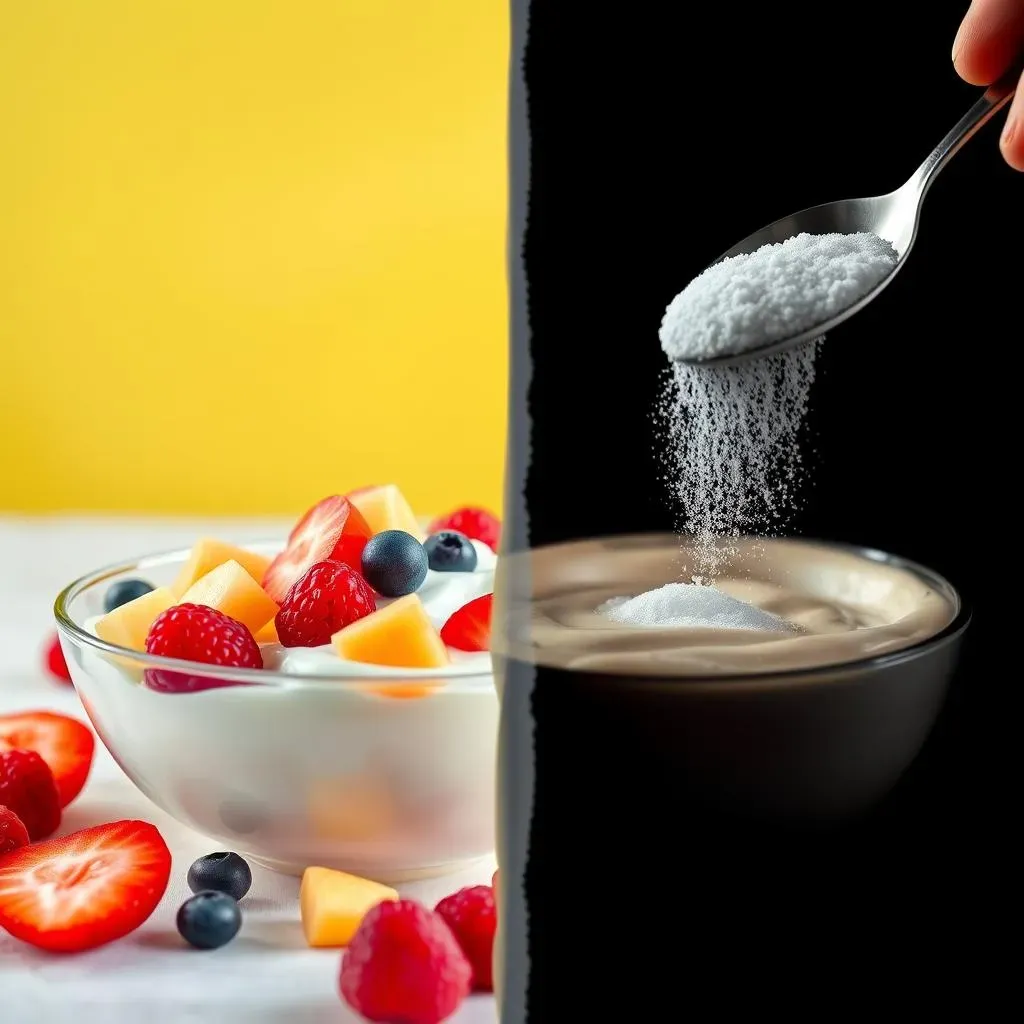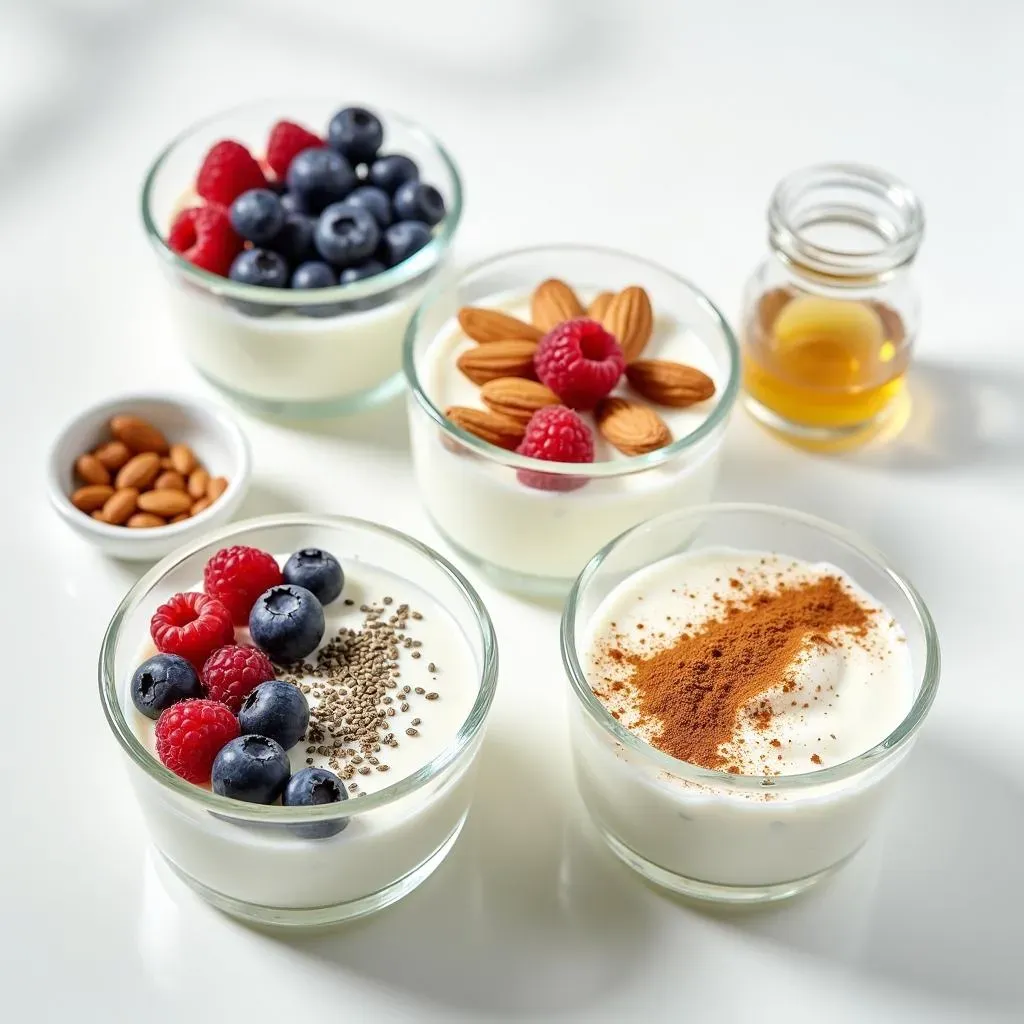Table of Contents
Ever stood in the yogurt aisle, feeling totally lost? You're not alone. With so many options promising health benefits, it's tough to know what's actually good for you. We're bombarded with claims like "low fat" and "no added sugar," but what do they really mean? This article is your guide to navigating the world of low fat low sugar yogurt. We'll break down the sneaky sugars hiding in your favorite brands, teach you how to read labels like a pro, and reveal the best picks that dietitians actually recommend. Forget the confusion and get ready to make smart, tasty choices for your health. We’ll cover why cutting back on added sugars is important, the difference between natural and added sugars, and the best low fat and low sugar yogurt options available today. We'll also look at how to enjoy these yogurts without sacrificing flavor, so you can feel good about what you're eating. Let's get started!
Understanding the Sugar in Your Yogurt

Understanding the Sugar in Your Yogurt
The Sneaky Sugars in Yogurt
let's talk sugar. It's not all created equal, especially when it comes to yogurt. You've got natural sugars, which come from the milk itself (that's lactose), and then you've got added sugars, the stuff manufacturers toss in to make it taste sweeter. These added sugars are the real culprits. They can be hiding under names like cane sugar, high-fructose corn syrup, or even honey. And that's just the start, the amount of added sugar in some yogurts is honestly wild. They're not your friend. The Dietary Guidelines for Americans suggest that no more than 10% of your daily calories should come from added sugars. So, picking the right yogurt can be a game-changer.
It’s easy to think that all yogurts are healthy. The reality is that many are packed with added sugars. Think of that fruit-on-the-bottom yogurt you loved as a kid? It's often more dessert than health food. These excess sugars can lead to energy crashes and can contribute to long-term health issues, which is definitely not the goal. So, before you grab that next yogurt cup, take a peek at the ingredients list and nutrition label. It can be a bit of a detective job, but it's worth it.
Decoding the Label: Added vs. Natural Sugars
Now, let’s get into the nitty-gritty of labels. The nutrition label will show you the total sugars and also the added sugars. This is where you need to pay close attention. The "total sugars" includes both natural sugars (lactose) and added sugars. You want to focus on the "added sugars" line. Ideally, you're looking for a yogurt with zero or very little added sugars. Remember, lactose is naturally occurring in milk, so a small amount of sugar is expected, but that's not the issue, the added sugar is. It's okay to have some natural sugar in your yogurt, but the added kind is what you should try to avoid as much as possible.
I know this can sound confusing, but once you get the hang of it, it becomes second nature. Think of it like this: natural sugars are like the natural sweetness of an apple, while added sugars are like the extra sugar you sprinkle on top. One is part of the fruit and the other is extra. It's all about making informed choices. It's about becoming a label-reading ninja. You can do it. Trust me, your body will thank you later.
Type of Sugar | Source | Impact on Health |
|---|---|---|
Natural Sugars (Lactose) | Naturally found in milk | Provides energy, generally okay in moderation |
Added Sugars | Added during processing (cane sugar, high-fructose corn syrup, etc.) | Can lead to energy crashes, weight gain, and long-term health issues |
Navigating Low Fat and Low Sugar Options

Navigating Low Fat and Low Sugar Options
The Low-Fat Myth and Why It Matters
so we've tackled the sugar monster, but what about fat? For years, we've been told that low-fat is the way to go, but it's not quite that simple. When manufacturers remove fat, they often add extra sugar to compensate for the loss of flavor. This is a sneaky trick, and it's why you need to be a label detective. It's not all about low fat anymore. The real goal is to find a balance between low fat and low sugar. You don't have to fear fat, you just need to be smart about the kind of fat you consume. Healthy fats, like those found in nuts and avocados, are actually good for you. The key is to not go overboard and to be aware of the trade-offs.
So, what should you look for? When it comes to yogurt, aim for options that are low in both fat and added sugars. Don't be afraid of full-fat yogurt if it's also low in sugar. It might actually keep you feeling full longer, which can help with weight management. The key is to read the labels and make choices that align with your overall health goals. It's not about deprivation, it's about making informed choices that nourish your body. The goal is to find that sweet spot where you're not sacrificing taste for health, or health for taste.
Decoding Different Types of Yogurt
Now, let's talk about the different kinds of yogurt you'll find in the store. We've got regular yogurt, Greek yogurt, Icelandic yogurt (also known as skyr), and plant-based options. Greek and Icelandic yogurts are generally higher in protein and lower in natural milk sugar (lactose) compared to regular yogurt. This makes them a great choice if you're looking for a filling and nutritious option. They also tend to be thicker and creamier, which is a win-win.
Plant-based yogurts, made from soy, almond, or coconut, can be a good alternative if you're avoiding dairy. However, many of these options can be higher in added sugars because they are sometimes added to enhance the taste. So, always check the labels. The best approach is to try a few different types and see what you like. It's all about finding something that fits your taste buds and your health goals. Remember, the best yogurt for you is the one that you enjoy and that fits into your overall healthy eating plan. It's not about perfection, it's about progress.
Yogurt Type | Typical Fat Content | Typical Sugar Content | Protein Content |
|---|---|---|---|
Regular Yogurt | Variable (Low-Fat to Full-Fat) | Moderate to High (Including Added Sugars) | Moderate |
Greek Yogurt | Low-Fat to Full-Fat | Low (Mostly Natural Sugars) | High |
Icelandic Yogurt (Skyr) | Low-Fat | Low (Mostly Natural Sugars) | Very High |
Plant-Based Yogurt | Variable (Low-Fat to Full-Fat) | Variable (Can be High in Added Sugars) | Variable |
Top Low Fat Low Sugar Yogurt Picks and How to Enjoy Them

Top Low Fat Low Sugar Yogurt Picks and How to Enjoy Them
Our Top Low Fat Low Sugar Yogurt Recommendations
Alright, let's get to the good stuff: the actual yogurts I recommend. It's time to move past the confusion and talk about some specific brands that make the cut. Remember, we're aiming for low fat and low added sugar, which might seem like a tall order, but trust me, they exist. Brands like Fage Total 0% Milkfat Plain Greek Yogurt and Chobani Plain Non-Fat Greek Yogurt are great starting points. They're both packed with protein and have no added sugar, giving you a blank canvas to add your own flavors. Siggi's Skyr is another fantastic option, known for its high protein and low sugar content. If you’re looking for something plant-based, try brands like Kite Hill or Forager Project, just make sure to check their labels for added sugars.
Finding these yogurts is like a treasure hunt, but it's a hunt worth undertaking. I know that sometimes the plain stuff can seem boring, but that's where your creativity comes in. Think of it as your chance to become a yogurt artist. You're in charge of the flavors, and you're in control of what goes into your body. Plus, these brands are usually pretty easy to find in most grocery stores, so you won't have to go on an epic quest to get your hands on them. It’s all about making informed choices that are both healthy and delicious.
Don't be afraid to experiment with different brands and flavors until you find your favorites. The world of low fat low sugar yogurt is more diverse than you think. It’s about finding something you look forward to eating, not something you feel like you have to eat. Let’s be honest, no one wants to eat something that tastes like cardboard. So, let’s dive into how we can make these healthy yogurts taste amazing. It's all about the right additions.
How to Enjoy Low Fat Low Sugar Yogurt
so you've got your low fat low sugar yogurt, but now what? Plain yogurt can seem a bit, well, plain. But that's where the fun begins. You can add your own toppings to boost the flavor and nutritional value. Fresh berries like blueberries, raspberries, and strawberries are a great choice. They add natural sweetness and antioxidants. A sprinkle of nuts or seeds, like almonds, walnuts, or chia seeds, can add some healthy fats and a satisfying crunch. You could even mix in a bit of cinnamon for a touch of warmth and flavor.
I like to think of it as building my own yogurt masterpiece. It's all about being creative. You can also use yogurt in smoothies, dips, and even as a substitute for sour cream in recipes. The possibilities are endless. The key is to avoid adding too much sugar. If you need a little extra sweetness, try a drop of stevia or a small drizzle of honey, but go easy on it. Remember, it's all about balance. The goal is to enjoy your yogurt without sabotaging your health goals. It’s about making healthy eating fun and sustainable.
Topping | Benefits |
|---|---|
Fresh Berries | Natural sweetness, antioxidants |
Nuts & Seeds | Healthy fats, crunch |
Cinnamon | Warmth, flavor |
Stevia or Honey (Small Drizzle) | Additional sweetness (in moderation) |
Making Smart Choices for a Healthier You
Choosing the right yogurt doesn't have to be a chore. By understanding the difference between natural and added sugars, and knowing what to look for on the nutrition label, you can confidently select a low fat low sugar yogurt that fits your health goals. Remember, plain, unflavored options are often the best starting point, and you can always add your own natural flavors. Don't be fooled by marketing claims, and be mindful of portion sizes. Ultimately, making informed choices about what you eat is a powerful step towards a healthier and happier you. So, go ahead, grab that spoon, and enjoy a yogurt that's both delicious and good for you.
